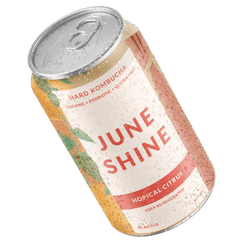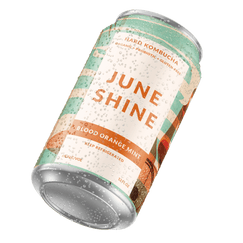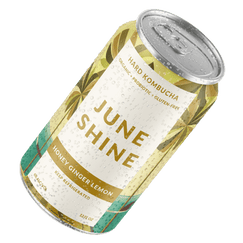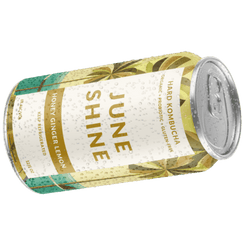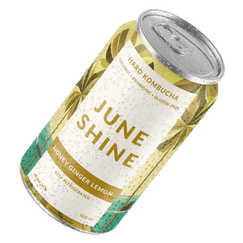What Is Alcoholic Fermentation? The Science Behind It

If you enjoy the occasional alcoholic beverage as much as our team does, then you are no stranger to alcoholic fermentation. If you’re new to the world of hard booch, fermentation is what makes alcohol, well, alcohol. And it’s way more scientific than you might think when you’re enjoying a can of Midnight Painkiller.
Ancient Fermentation Practices
Let’s go back nine thousand years ago, when the earliest known instance of deliberate fermentation occurred in ancient China. Scientists discovered residue in clay pots which revealed that the Chinese were making alcoholic beverages from fermented rice, fruit, and honey.
Around the same time, corn became a domesticated crop, followed by the harvesting of grapes a thousand years later. Soon, cultures all over the world started fermenting their own drinks.
Ancient Mesopotamians and Egyptians developed a palate for beer and made it from stored cereal grains. In Greece and Rome, where grapes grew more easily, wine became an instant hit, and Michelangelo held the first paint-and-sip at the Sistine Chapel.
Alcohol became a part of everyday life. The drinks in each culture were largely based on the plants that were most dominant in the region. For example, chichi was made from cactus sap in what is now Mexico, while fermented rice, known as saké, became popular in what’s now modern-day Japan.
What the Buzz Was All About
The alcohol content of these ancient fermented drinks was limited to around 13% because the by-product that wild yeasts generate during fermentation becomes toxic and kills them when the ABV gets too high. Without yeast, there can be no more fermentation and, thus, no more alcohol.
All that changed when we discovered the process of distillation. In the ninth century, Arabic peoples started boiling fermented liquids to vaporize the alcohol in them. More on that process later.
These newly-created stronger spirits were first used for medicinal purposes, but later they became a popular commodity because they didn’t spoil as beer and wine did.
Certain areas of the world became known for different spirits. Rum, a popular drink made from sugar harvested in the Western Hemisphere, became the drink of choice among sailors. Spirits became a form of money in certain regions of Africa during periods of trade, and brandy was even used to keep water supplies fresh during long sea voyages.
By the 1600s, alcohol was a major part of human society. We (probably) started making our hard kombucha to advance the hard work of those before us.
The Science of Fermentation
Now that you know the rich history of alcoholic fermentation, let’s discuss the science behind it.
The basic building blocks of fermentation come down to yeast. Yeast is a eukaryotic microorganism that can metabolize sugar anaerobically (without oxygen) through ethanol fermentation. In simpler terms, fermentation breaks a substance down into a simpler substance.
When there is no available oxygen, fermentation occurs. The main purpose of fermentation is to create ATP, the source of energy for use and storage at a cellular level. So, for yeast, carbon dioxide and ethanol are considered waste products. The carbon dioxide is why you see bubbles in your drinks, and the ethanol is the alcohol.
Fermentation happens in two parts. In part one, the yeast breaks down the glucose into two molecules in a process known as glycolysis. From there, the molecules are converted into two carbon dioxide molecules and two molecules of ethanol.
In the second, longer fermentation stage, lasting several days to many weeks, the alcohol levels rise and the yeast and microbes die off. In this stage, alcohol can reach between 12 to 15% before the yeast dies and prevents further fermentation.
Raising ABV With Distillation
If you’re aiming for hard liquor, you need another step to increase the ABV. Enter distillation.
Distillation is a process of deliberate evaporation, cooling, and condensation that creates purified liquids. This process takes advantage of the fact that alcohol boils at a lower temperature than water, so it vaporizes first. Capturing this vapor and cooling it creates alcohol that’s much more concentrated than its fermented brothers and sisters. More condensed means a higher ABV.
Once the base yeast digests all of the sugars and produces ethanol and carbon dioxide, that remaining liquid, usually with a low ABV of around 10-15%, is added to a still. Once in the still, the liquid is heated till it vaporizes, and then it condenses and drops back into the pot.
Fermenting JuneShine Hard Kombucha
There you have it—a beginner’s guide to alcoholic fermentation. Fermentation needs to have a starter culture. Kombucha uses what is known as a SCOBY to ferment tea. All kombucha is a little boozy by nature, but we took it to the next level by adding a few tweaks in the second round of fermentation to make our hard kombucha hit hard.
If heading back to science class with a splash of history mixed in made you thirsty, we know exactly what will take you back down from your brain blast. Hint: it’s fizzy, tart, and oh-so-smooth.
Sources:
The science of alcohol: 3 The long history of alcohol - OpenLearn - Open University - SOA_1
fermentation Dictionary Definition | vocabulary.com
Ability to consume alcohol may have shaped primate evolution | Science Mag
Rod Phillips: A brief history of alcohol | TED
Yeast, Fermentation, Beer, Wine | Learn Science at Scitable | Nature.com
Hominids adapted to metabolize ethanol long before human-directed fermentation | PNAS
Why, when, and how did yeast evolve alcoholic fermentation? | NCBI

